The Year of Angular on .NET Core, WebAssembly, and Blazor: 2019 in Review
The JavaScript monopoly is broken
Part of the series: Year End Summaries
What an awesome year! 2019 had lots of great milestones. Every year of my professional career has been exciting, and 2019 was no different. It was my first full year living in the Pacific Northwest and my second full year employed at Microsoft. I continued to travel the world.
According to TripIt I covered 124,570 miles (200,476 km) over 17 trips across 26 cities in 10 countries. I was away for 92 days of the year, which is way too much (I’ll be fixing that this coming year!). The places I visited include:
- Amsterdam, Netherlands (one of my favorite cities)
- Atlanta, GA (former home town!)
- Cabo San Lucas, Mexico (first time)
- Chicago, IL
- Hong Kong, China (first time and loved it)
- Johannesburg, South Africa (first time, awesome place)
- Mumbai, India (first time, amazing history there)
- Orlando, FL (hi, Mom and Dad!)
- Oslo, Norway (first time in the land of my ancestors)
- San Diego, CA (first time, incredible climate)
- Toronto, Canada (brrrrrr…)
- Wisconsin Dells, WI
Quick Detour: 25 Years of Professional Development
I had to pause for a moment writing this blog post to celebrate 25 years (cough, yes, cough, a quarter century) of earning a living doing what I love: writing code and empowering developers to do the same. This is a quick, personal look back at the arc my career has taken. (Not interested? No problem - click here for the next section).
- 1994 Wrote RPG on an AS/400 (now iSeries) for an insurance company.
- Learned SQL
- Published my first technology articles
- 1996 Relocated to Atlanta, met my wife, joined a small company that I knew wouldn’t last long.
- My first exposure to “CASE” tools
- Spent a lot of time building custom Quake mods
- 1997 Joined the supply chain software company where I acquired a large amount of my programming knowledge.
- Worked on a very early line of business web app that featured a custom navigation journal, XSLT-based rendering engine, and XML-based web services
- The company was private with about 100 employees when I joined, then went public and was international with thousands of employees when I left
- 2002 Lost weight and started a part-time fitness training company.
- Changed jobs to apply my passion for health and fitness
- Had no idea the role I would be given was Director of IT
- Built the architecture and wrote most of the code for a multi-lingual, multi-tenant, white-labeled web platform
- Negotiated my first online hosting contract
- Negotiated my first business phone plan contract that saved us tens of thousands
- Helped the company more than double in size
- 2004 Decided to “jump first, build the parachute on the way down”
- Quit my job to start my own fitness company full time
- Briefly relocated to South Dakota and quickly decided that blizzards in May are not cool (heh)
- Relocated to a small house on St. Pete Beach in Florida
- 2006 After three years and almost $100k of debt, managed to turn my business around to earn almost six figures of revenue (compared to total revenue of ~$10k the first year … ouch)
- Received a phone call from a multimillionaire who asked me if I’d help him build a new software company (he was one of the co-founders of the company I joined in 1997) and I said “yes”
- Joined as the third employee and Director of IT, moved back to Atlanta
- Set up my first (professional, non-IPX) network (wasn’t pretty) then hired a network admin
- Built out my first data center rack (you don’t want to know what that looked like) then hired a data center operations manager
- Kept learning new technology areas then hiring out of them so I could keep my focus on development
- Built my first apps to massive scale handing hundreds of thousands of concurrent connections
- Built my first mobile apps
- Deployed my first app to the cloud for elastic scale
- Implemented a fully automated DevOps pipeline including database upgrades, entirely based on a custom tool chain because we didn’t have the software available today
- Started my technology blog to and write about problems I was solving day-today
- My very first technology-focused blog post was on March 24, 2009: NHibernate and Complex Types for Native Keys
- Wrote one of my most read posts of all time, which ironically was a very short tip on how to use
setTimeoutto avoid a DOM issue specific to Internet Explorer 6: JQuery, IE6, and ‘Could not set the selected property. Unspecified error.'
- 2009 Ended five years of startup mode and working 100 hours/week by making a major lifestyle change.
- Left the company with no vested stock to join a work-from-home consulting firm
- Turned my life around because my wife retired in 2006 and my daughter was home schooled so we suddenly had tons of quality time together
- Helped build some of the first large scale apps on the Silverlight platform
- Began my public speaking career in technology
- Recorded my first video series
- Wrote and contributed to four technology books
- 2014 I really enjoyed consulting but wanted to take on new challenges, so I left the company without a specific plan in mind.
- Created my personal mission statement to empower developers to be their best and began the process of forming a new company with that goal in mind
- A former colleague saw that I was “on the market” and asked if I’d join his company to help build a new application development consulting practice. This was aligned to my mission and given the existing company infrastructure would make it easier to hit the ground running, so I joined
- Became Practice Lead and owned/grew a multi-million dollar practice
- The company was known for their managed services, so I allocated budget for sponsoring, speaking, and blogging to build the application development brand and connect with the Atlanta-centric community
- 2017 this was when a single tweet would change my life. I read this:
Excited I'll soon be joining the @azure team as a Developer Advocate in the Cloud & Enterprise group! We're hiring! https://t.co/LuQMVMwnWu pic.twitter.com/rJuT13nt98
— John Papa (@John_Papa) February 17, 2017
…and immediately thought to myself, “Good for him.” I knew it a had to be a great role for him to make the switch, and I enjoyed watching the updates coming from the team with envy. I wasn’t unhappy and wasn’t looking, but a random email would change everything. A recruiter from Microsoft reached out, and after overcoming my initial shock (“Why are they interested in me?") I went on to interview and, well, here I am today, a Cloud Developer Advocate. What will the next 25 years bring?
Retrospective: Major Goals for 2019
Let’s get into some more interesting goals and stats. For reference, this was my 2018 post.
How did I do with my goals for 2019? Here are my retrospective comments.
The Goal: get back into a regular fitness routine and closer to my “fighting weight” of 200 pounds
The Result: ⚠ mixed … although I’m not closer to 200, I’ve managed to keep a regular training routine throughout the year. I was mostly jogging and doing bodyweight calisthenics in the summer and fall and shifted to more weight training in my home gym for the cold, dark winter months.
The Goal: summit a mountain I haven’t been on before (sound familiar?)
The Result: ✅ success! I successfully reached the summit of several new mountains, including:
🗻 Heybrook Lookout 1700’ (518m)
🗻 Dragon’s Back (Hong Kong) 931' (284m)
🗻 Beckler Peak 5026' (1532m)
🗻 Mount Pilchuck 5327' (1624m)
🗻 Mount Dickerman 5760' (1756m)
The Goal: ski for the first time in years
The Result: ✔ tentative success … as of this writing I plan to ski the last week in December.
The Goal: speak to an audience of more than 1,000 (quantity doesn’t matter, but it’s a bucket list item that makes it easier to speak to larger audiences moving forward)
The Result: ✅ success! I achieved this goal multiple times the past year, thanks to Microsoft Ignite | The Tour and an invitation to keynote CodeStock.
The Goal: vacation with my wife in a place we haven’t been before
The Result: ✅ success! We had an amazing mini-vacation in Oregon.
…then, we took a longer trip down to Baja Mexico.
The Goal: increase my giving (not just dollars, but mentoring, community service, etc.)
The Result: ⚠ I can still do more here.
In other news, my daughter graduated college with her Bachelor of Political Science at 19 years old (with an awesome GPA).
Sadly, my brother-in-law was diagnosed with cancer and died within the year. Rest in peace, Steve!
My Goals for 2020
Here are my goals for 2020:
- Advance my career (promotion? change roles? we’ll see!)
- Travel less
- Continue to exercise consistently
- Summit at least four (4) new mountains
- Volunteer at my church
Health Stats
Health is a goal of mine and it’s a topic not discussed enough in technology. For that reason, I’m going to start including health statistics in my year end summaries. Not interested? Jump to Open Source.
Last year I engaged in 174 activities. I walked, ran, and hiked 242 miles and spent 109 hours in training. I climbed 27,999 feet (8534m) elevation during the year. I climbed between 260 - 820 flights of stairs each month and took between 178,767 and 255,979 steps per month. I average around 7 hours of sleep per night. I almost always average closer to 8 hours at home and less than 6 on the road.
My average resting heart rate ♥ was 48 beats per minute. I’ve always had a low heart rate and it slows when I train consistently. My most recent blood pressure reading was 117/79. My most recent cholesterol reading was 193 (44 HDL, 113 LDL). In spite of following a 100% plant-based (vegan) diet for five years, my levels of B12, iron, Vitamin D and Calcium all remain normal.
I have hypothyroidism and take medication to regulate my thyroid hormone levels.
In the past year I developed a tremor in my left arm. Initially it was just an issue of my hand shaking randomly, but more recently I’ve lost dexterity in that hand and have trouble articulating my fingers. The main negative impact is that my typing speed has slowed. I’ve seen seven different doctors who inspected my wrist, elbow, shoulder, and neck, including taking MRIs of my neck and head, and still have no diagnosis. The next step is a special scan to rule out Parkinson’s disease. It will be interesting looking back at the end of next year to see how my quest to diagnose and treat this tremor unfolds.
Let’s move onto technical insights.
Open Source
I had more open source contributions in 2019 than 2018 and 2017.
 GitHub contributions in 2019
GitHub contributions in 2019
I continued to work with docs, but a major difference was the result a focus on making my presentations more “open source” and not just publish the source code but include “train the trainer” content to make it easier for other presenters to reuse my work. I 100% support forking my presentations and code to either present to a new audience “as is” or customize/personalize and save time getting a new presentation done. This is all part of my personal mission to empower developers, and one way to scale is by enabling other presenters. This is why I also wrote a 9-part Comprehensive and Practical Guide to Technical Presentations.
Twitter in Review
My followers grew from 11,524 in 2018 to 13,102 this year. That’s a 14% increase and about equal to my growth in 2018 (about 4 followers per day). Followers don’t mean much if they are bots or don’t read and engage with content, so my one Twitter-focused goal was to increase engagement.
The Result: ✅ success! I had a record year of engagement. I also hit a personal record with one million tweet impressions in a single month! This wouldn’t have been possible without an engaged network willing to retweet content.
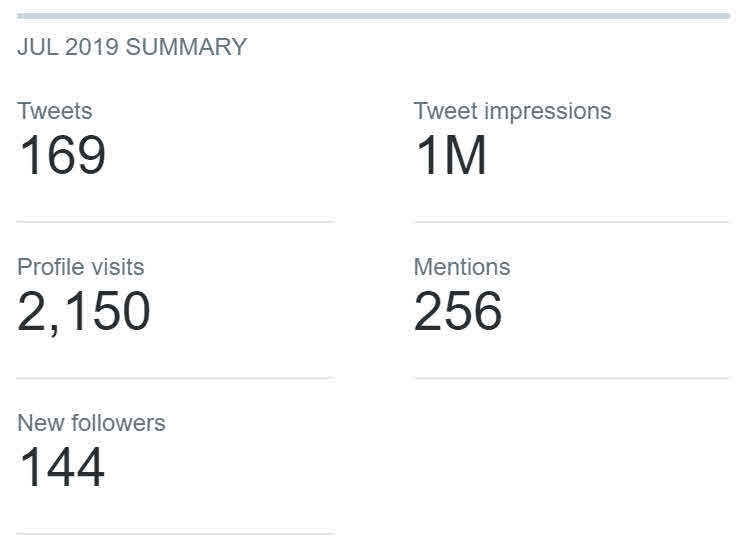 Twitter stats for July 2019
Twitter stats for July 2019
As always, the following stats are based on the last 90 days.
Demographics
The interests of my followers shifted slightly from previous years. The top five interests include:
- Science news (98%, down from 99%)
- Technology (98%, down from 99%)
- Tech news (97%, down from 98%)
- Dogs (96%, up from 92%) … interesting (see what I did there?)
- Space and astronomy (96%, down from 99%)
Although the percentage is “down” it really means my followers have more diverse interests, so I see the change as a net positive.
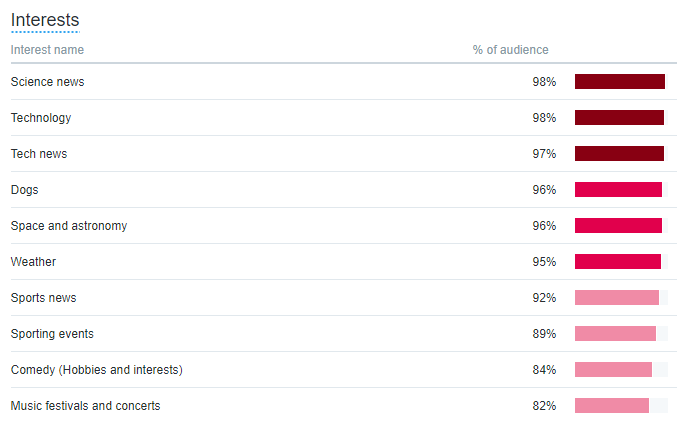
Twitter interests in 2019
I’m also seeing a positive trend in the diversity of followers. The main stat I have to go on for this is the binary gender tracked by Twitter. In 2017 I had 13% female followers. That increased to 20% (1 in 5) in 2018 and for 2019 is at 24% or 1 in 4. I hope this reflects open, welcoming, and supportive content for everyone in my feed.
I gained more international followers this year as the percentage from the United States dropped from 41% to 38%. The top five counties following me in order outside of the U.S. are:
- United Kingdom
- India
- Canada
- France
- Australia
There are a lot of other stats that I don’t pay too much attention to as they are more geared to marketing than having engaged and empowered followers.
Top Tweets
The most impressions for any tweet this year was a reference to a Microsoft Learn module with a hands-on lab to build a real-time app.
Hands-on, step-by-step lab with full sandbox (no #Azure subscription required) shows how to build a real-time #webapp and process updates with #SignalR and Azure Functions @AzureFunctions then host it in Azure Storage with Static Websites: https://t.co/1Z9WbHyfnr pic.twitter.com/QEnPITJ4UV
— Jeremy Likness ⚡️ (@jeremylikness) June 4, 2019
My top mention (don’t @ me!) was a post by Christian Nwamba that featured a picture with Anders Hejlsberg, the creator/co-creator of C#, TypeScript, Turbo Pascal and lead architect of Delphi.
Hey @jeremylikness @holtbt @ahejlsberg pic.twitter.com/3ZZTrifLd6
— Christian Nwamba (@codebeast) May 6, 2019
Finally, the top “media tweet” was a post showing how to build, edit, view, design, and deploy Azure Logic Apps.
Did you know you can 🚧 build, 📝 edit, 👀 view, 🖼 design, and ⬆ deploy #Azure #Cloud ☁🖇 integrations using Logic Apps directly from #VisualStudio @Code? Here is a step-by-step tutorial showing how: https://t.co/K8YvNSANWn pic.twitter.com/1SA2vOItbq
— Jeremy Likness ⚡️ (@jeremylikness) April 3, 2019
Although Twitter is an important way for me to connect with developers, my focus last year was on authoring more original content and not simply curating other articles.
The Practical Developer: A New Place
Last year I joined a new community called dev.to. It is an open source project and incredibly welcoming community with daily posts, discussion, polls, and more. I authored some original content and began syndicating articles there. After my initial post in April 2019, I had:
- 50,640 readers of content
- 1,741 reactions to content
- 47 comments
- 5,020 followers
I’ll continue to post both original and syndicated content there in 2020.
Developer for Life in Review
Last year was flagship year for my blog. Although I moved it (again), this time I preserved the domain and links so I have a consistent view of traffic. I ported it from Medium to Hugo and wrote a series of posts about the migration. This allowed me to take full control over the site, code, and templates. I was able to build a CI/CD pipeline that allows me to edit posts in markdown then commit to my GitHub repo to publish. In addition to open sourcing my blog, I also implemented it as a Progressive Web App (PWA). Over the year I received 96,047 visitors over 123,961 sessions, about a 30% increase from the previous year. Countries were similar with a little more traffic incoming from Germany and the Netherlands compared to the past.
Almost three-quarters of incoming traffic is from organic search.
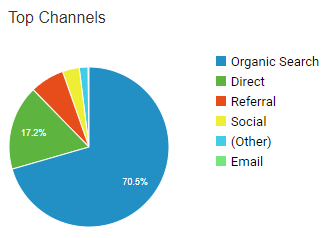
Acquisition for Developer for Life in 2019
7 out of the top 10 search terms driving traffic to my blog included the word Blazor. Other popular terms were Mongo DB, Docker, and Angular.
The top three third party referrals came from:
- The Morning Brew
- The ASP.NET “Community Spotlight”
- My site listed as a JAMStack example
Here are the top 10 pages. The data is slightly skewed because the links under root (no /blog prefix) are redirects to preserve the original URLs from Medium.
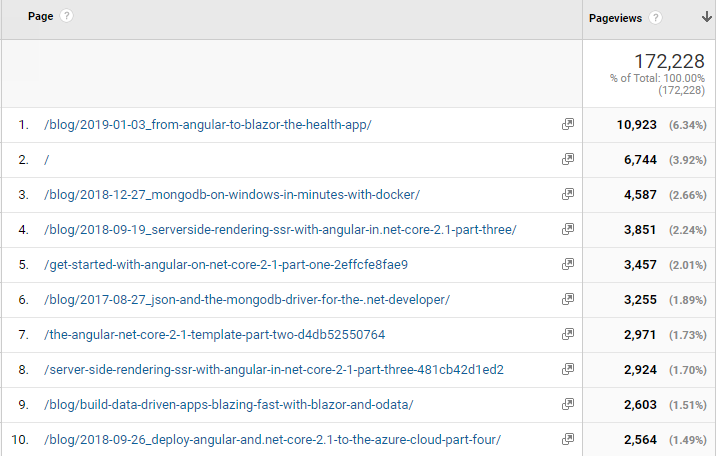
As you can see, popular topics included Angular on .NET Core and Blazor.
Links and Click Data
I’ve been running a custom serverless link tracker for a few years now and use it to understand what followers and readers are interested in. For 2019 I analyzed just under 200,000 clicks (down about 9% from last year, but I’m also writing this earlier). A few notable data points:
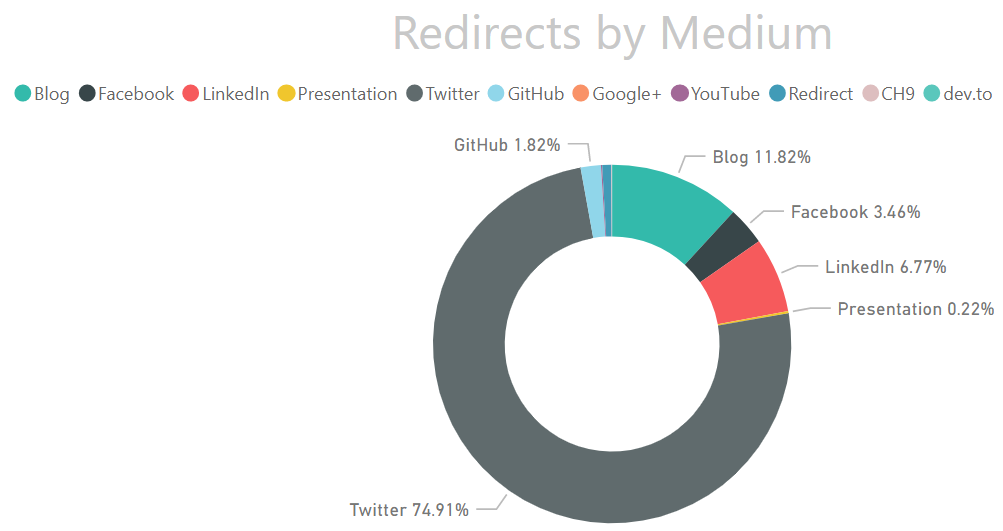 Redirects in 2019 by medium
Redirects in 2019 by medium
Twitter continues to dominate the source of clicks. Compared to last year, I saw increases in activity from GitHub, my blog, LinkedIn, and Facebook. In fact, although Facebook barely registered last year, it accounted for 3.5% of traffic this year. I have a dedicated Facebook page for Jeremy Likness that I post data to. (No, I’m not suddenly referring to myself in the 3rd person, that was for the search engines.)
The top five clicked links (aside from my blog homepage) last year were:
- My example Blazor Health app
- An comprehensive article about WebAssembly
- The official documentation to use the Angular project template with ASP.NET Core
- F# in the Browser with WebAssembly and Bolero
- An article about debugging your .NET Core on Docker apps with Visual Studio Code
The most popular ongoing source of links included the Blazor-related articles on my blog and my GitHub repo with a hands-on Blazor walkthrough.
The top three sites I sent traffic to were:
The top three clicked tweets based on my own link tracker were:
One 1️⃣ 🥇
Writing Single Page Apps (SPA) with #WebAssembly using #CSharp and #dotnet: from #Angular to #Blazor with a reference health app https://t.co/6Wf4tXcx01 pic.twitter.com/Gtv1A7DA84
— Jeremy Likness ⚡️ (@jeremylikness) January 3, 2019
Two 2️⃣ 🥈
The #Azure architecture guide
— Jeremy Likness ⚡️ (@jeremylikness) September 11, 2019
🧱 Architecture styles
🎨 Design principles
💻 Technology choices
👍 Best practices
🔧 Performance tuning
🚫 Performance anti-patterns
📚 Azure for #AWS professionalshttps://t.co/lMoE0n6MPc pic.twitter.com/rZXkGBbbUH
Three 3️⃣ 🥉
I decided to run another 🕸 #WebAssembly experiment.
— Jeremy Likness ⚡️ (@jeremylikness) March 7, 2019
This time, I decided to go with 🦀 Rust #Rustlang to generate the #Wasm to tap into the power of @rustwasm.
I was blown away by what I found!
Read about the journey to supercharge #JavaScript here:https://t.co/y94HXdY1dE pic.twitter.com/GLO63An83p
17% of clicks were from mobile devices.
Closing Thoughts
If there is one word that sums up 2019 for me, it’s Blazor. Many .NET developers around the world are embracing this new platform. WebAssembly has officially broken JavaScript’s browser monopoly and is empowering C, C++, C#, Go, Rust, TypeScript and other developers to build full stack experiences without having to leave the language of their choice. When I look back at the past three years, I see this trend:
- 2017 Docker and Serverless - package and scale your code
- 2018 .NET Core - build your code for any platform
- 2019 WebAssembly - target one platform that runs everywhere
I’m often asked what I think the “next big thing” will be. I believe that 2020 will be the year that WebAssembly and modern JavaScript truly shine. We’ll see WebAssembly appearing in places outside of the browser and tooling evolve to embrace building experiences that need only target a single platform to run everywhere. Developers are closer than ever to building experiences for every platform, including servers, laptops, tablets, mobile phones, gaming consoles, edge devices and web browsers, with the language and tools of their choice. What an exciting time!
See you in 2020.

Part of the series: Year End Summaries
- The Year of Docker, Serverless, and .NET Core: 2017 in Review
- The Year of .NET Core, Angular, and Web API Design: 2018 in Review
- The Year of Angular on .NET Core, WebAssembly, and Blazor: 2019 in Review
